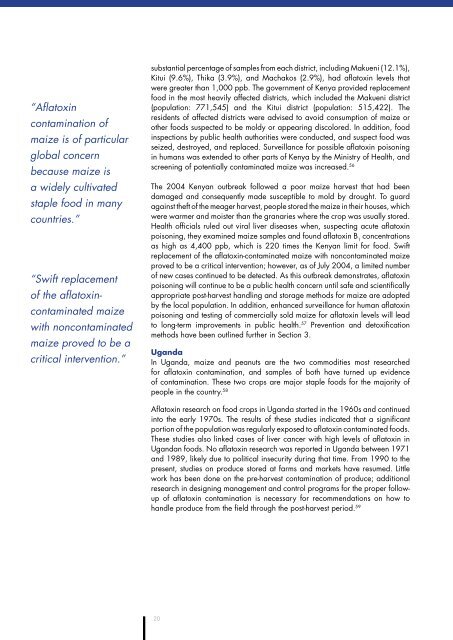Aflatoxin: A Synthesis of the Research in Health, Agriculture and Trade
Aflatoxin: A Synthesis of the Research in Health, Agriculture and Trade
Aflatoxin: A Synthesis of the Research in Health, Agriculture and Trade
Create successful ePaper yourself
Turn your PDF publications into a flip-book with our unique Google optimized e-Paper software.
“<strong>Aflatox<strong>in</strong></strong><br />
contam<strong>in</strong>ation <strong>of</strong><br />
maize is <strong>of</strong> particular<br />
global concern<br />
because maize is<br />
a widely cultivated<br />
staple food <strong>in</strong> many<br />
countries.”<br />
“Swift replacement<br />
<strong>of</strong> <strong>the</strong> aflatox<strong>in</strong>contam<strong>in</strong>ated<br />
maize<br />
with noncontam<strong>in</strong>ated<br />
maize proved to be a<br />
critical <strong>in</strong>tervention.”<br />
substantial percentage <strong>of</strong> samples from each district, <strong>in</strong>clud<strong>in</strong>g Makueni (12.1%),<br />
Kitui (9.6%), thika (3.9%), <strong>and</strong> Machakos (2.9%), had aflatox<strong>in</strong> levels that<br />
were greater than 1,000 ppb. <strong>the</strong> government <strong>of</strong> Kenya provided replacement<br />
food <strong>in</strong> <strong>the</strong> most heavily affected districts, which <strong>in</strong>cluded <strong>the</strong> Makueni district<br />
(population: 771,545) <strong>and</strong> <strong>the</strong> Kitui district (population: 515,422). <strong>the</strong><br />
residents <strong>of</strong> affected districts were advised to avoid consumption <strong>of</strong> maize or<br />
o<strong>the</strong>r foods suspected to be moldy or appear<strong>in</strong>g discolored. <strong>in</strong> addition, food<br />
<strong>in</strong>spections by public health authorities were conducted, <strong>and</strong> suspect food was<br />
seized, destroyed, <strong>and</strong> replaced. Surveillance for possible aflatox<strong>in</strong> poison<strong>in</strong>g<br />
<strong>in</strong> humans was extended to o<strong>the</strong>r parts <strong>of</strong> Kenya by <strong>the</strong> M<strong>in</strong>istry <strong>of</strong> health, <strong>and</strong><br />
screen<strong>in</strong>g <strong>of</strong> potentially contam<strong>in</strong>ated maize was <strong>in</strong>creased. 56<br />
<strong>the</strong> 2004 Kenyan outbreak followed a poor maize harvest that had been<br />
damaged <strong>and</strong> consequently made susceptible to mold by drought. to guard<br />
aga<strong>in</strong>st <strong>the</strong>ft <strong>of</strong> <strong>the</strong> meager harvest, people stored <strong>the</strong> maize <strong>in</strong> <strong>the</strong>ir houses, which<br />
were warmer <strong>and</strong> moister than <strong>the</strong> granaries where <strong>the</strong> crop was usually stored.<br />
health <strong>of</strong>ficials ruled out viral liver diseases when, suspect<strong>in</strong>g acute aflatox<strong>in</strong><br />
poison<strong>in</strong>g, <strong>the</strong>y exam<strong>in</strong>ed maize samples <strong>and</strong> found aflatox<strong>in</strong> B 1 concentrations<br />
as high as 4,400 ppb, which is 220 times <strong>the</strong> Kenyan limit for food. Swift<br />
replacement <strong>of</strong> <strong>the</strong> aflatox<strong>in</strong>-contam<strong>in</strong>ated maize with noncontam<strong>in</strong>ated maize<br />
proved to be a critical <strong>in</strong>tervention; however, as <strong>of</strong> July 2004, a limited number<br />
<strong>of</strong> new cases cont<strong>in</strong>ued to be detected. As this outbreak demonstrates, aflatox<strong>in</strong><br />
poison<strong>in</strong>g will cont<strong>in</strong>ue to be a public health concern until safe <strong>and</strong> scientifically<br />
appropriate post-harvest h<strong>and</strong>l<strong>in</strong>g <strong>and</strong> storage methods for maize are adopted<br />
by <strong>the</strong> local population. <strong>in</strong> addition, enhanced surveillance for human aflatox<strong>in</strong><br />
poison<strong>in</strong>g <strong>and</strong> test<strong>in</strong>g <strong>of</strong> commercially sold maize for aflatox<strong>in</strong> levels will lead<br />
to long-term improvements <strong>in</strong> public health. 57 Prevention <strong>and</strong> detoxification<br />
methods have been outl<strong>in</strong>ed fur<strong>the</strong>r <strong>in</strong> Section 3.<br />
ug<strong>and</strong>a<br />
<strong>in</strong> Ug<strong>and</strong>a, maize <strong>and</strong> peanuts are <strong>the</strong> two commodities most researched<br />
for aflatox<strong>in</strong> contam<strong>in</strong>ation, <strong>and</strong> samples <strong>of</strong> both have turned up evidence<br />
<strong>of</strong> contam<strong>in</strong>ation. <strong>the</strong>se two crops are major staple foods for <strong>the</strong> majority <strong>of</strong><br />
people <strong>in</strong> <strong>the</strong> country. 58<br />
<strong>Aflatox<strong>in</strong></strong> research on food crops <strong>in</strong> Ug<strong>and</strong>a started <strong>in</strong> <strong>the</strong> 1960s <strong>and</strong> cont<strong>in</strong>ued<br />
<strong>in</strong>to <strong>the</strong> early 1970s. <strong>the</strong> results <strong>of</strong> <strong>the</strong>se studies <strong>in</strong>dicated that a significant<br />
portion <strong>of</strong> <strong>the</strong> population was regularly exposed to aflatox<strong>in</strong> contam<strong>in</strong>ated foods.<br />
<strong>the</strong>se studies also l<strong>in</strong>ked cases <strong>of</strong> liver cancer with high levels <strong>of</strong> aflatox<strong>in</strong> <strong>in</strong><br />
Ug<strong>and</strong>an foods. no aflatox<strong>in</strong> research was reported <strong>in</strong> Ug<strong>and</strong>a between 1971<br />
<strong>and</strong> 1989, likely due to political <strong>in</strong>security dur<strong>in</strong>g that time. from 1990 to <strong>the</strong><br />
present, studies on produce stored at farms <strong>and</strong> markets have resumed. little<br />
work has been done on <strong>the</strong> pre-harvest contam<strong>in</strong>ation <strong>of</strong> produce; additional<br />
research <strong>in</strong> design<strong>in</strong>g management <strong>and</strong> control programs for <strong>the</strong> proper followup<br />
<strong>of</strong> aflatox<strong>in</strong> contam<strong>in</strong>ation is necessary for recommendations on how to<br />
h<strong>and</strong>le produce from <strong>the</strong> field through <strong>the</strong> post-harvest period. 59<br />
20


